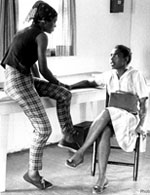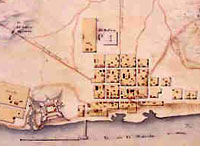African American Genealogy Tips
Tukufu Zuberi of PBS's History Detectives discusses the particular challenges of tracing African American family histories.
Tukufu Zuberi of PBS's History Detectives discusses the particular challenges of tracing African American family histories.
Shiloh National Military Park commemorates the battle of Shiloh, one of the bloodiest battles of the civil war. Fought in southwestern Tennessee, the battle claimed about 24,000 casualties, and served as a wake up call for both the Union and the Confederacy. The military park strives to present the battlefield in its original state, from treelines to buildings. In addition, the park contains miles of historical trails and roads for hikers and two visitor centers.
The site offers information about the battle and current day battlefield park as well as teacher resources.
The Tupelo National Battlefield marks the location of the Battle of Tupelo, the second battle in northeast Mississippi designed exclusively to keep Gen. Nathan Forrest in Mississippi and away from Gen. Sherman's forces in northern Georgia. While the battle itself was indecisive, Gen. Forrest himself was injured, and thus the battle represented a great strategic victory for the Union.
The battlefield offers exhibits at the Natchez Trace Parkway visitor center, as well as ranger-led tours of the battlefield. The website offers historical information regarding the battle as well as basic visitor information.
The Brices Cross Roads National Battlefield Site commemorates the site of the battle of Brices Cross Roads in 1863. Although the battle was a resounding Confederate victory, the battle hurt the Confederacy in the long run, as it allowed General Sherman uninterrupted supplies for his campaign in Georgia.
The park offers exhibits in the visitor center located several miles from the park, along with a self-guided tour and interpretive signs at the battlefield. The website offers visitor information and a brief history of the battlefield.
Natchez, Mississippi, is located on the banks of the Mississippi River and offers visitors a chance to explore life in the antebellum south. Natchez is home to the William Johnson House, the Cypress Swamp, and the Melrose Mansion, and so offers visitors a comprehensive view of southern culture, from the life of former slave William Johnson to the life of wealthy southerner John McMurran.
The historical park offers guided tours, field trip programs, and exhibits in the park visitor center. The website offers visitor information, curriculum materials for teachers, and a history of Natchez. In order to contact the park via email, use the "contact us" link located on the left side of the webpage.
The Vicksburg National Military Park commemorates the campaign, siege, and defense of Vicksburg. The fort surrendered on July 4, 1863, and, coupled with the fall of Port Hudson in Louisiana, gave control of the Mississippi River to the north. The park now contains a National Cemetery, restored Union Gunboat, and a visitor center.
The park offers guided tours, ranger-led activities, field trip programs, exhibits, an orientation film, and interpretive events. The website offers visitor information, a detailed history of the park and siege, an online exhibit, and a curriculum guide for teachers. In order to contact the site via email, use the "contact us" link located on the left side of the webapge.

These 150 oral history interviews and 16 collections of documents address the civil rights movement in Mississippi. Interviews were conducted with figures on both sides of the movement, including volunteers and activists as well as "race-baiting" Governor Ross Barnett and national White Citizens Council leader William J. Simmons.
Document collections offer hundreds of pages of letters, journals, photographs, pamphlets, newsletters, FBI reports, and arrest records. Approximately 25 interviews also offer audio clips. Users may browse finding aids or search by keyword. Six collections pertain to Freedom Summer, the 1964 volunteer initiative in Mississippi to establish schools, register voters, and organize a biracial Democratic party. One collection is devoted to the freedom riders who challenged segregation in 1961. Four explanatory essays provide historical context. Short biographies are furnished on each interviewee and donor, as well as a list of topics addressed and 30 links to other civil rights websites.
The Winterville Mounds comprise the remains of a religious and ceremonial center used by an unidentified Native American population between circa 1000 and 1450. After 1450, the site appears to have been entirely abandoned. The people who made use of the mounds were a scattered farming culture located throughout the Yazoo-Mississippi River Delta basin. A few high-ranking individuals appear to have lived near the mounds.
The site offers exhibits.
The Governor's Mansion is a 1842 Greek Revival Mansion which has served as Mississippi's gubernatorial residence since its erection. Most furnishings are Empire style (1810-1830), although the site also contains French Restoration (1830-1850), Rococo Revival (1850-1870), and Renaissance Revival (1860-1880) pieces.
The mansion offers period rooms and guided tours. Reservations must be made for groups of 10 or more. As the residence may be closed for state events, it is suggested that visitors call ahead to confirm that tours will be offered on the day which they wish to visit. The website offers small galleries of furniture images arranged by style, as well as floor plans.

Designed to showcase the work of archaeologists and their excavations at Mobile and elsewhere in Alabama, this website offers images and exhibits from several digs. Visitors can "virtually visit" archaeological sites in the town of Old Mobile, capital of the French colony of Louisiane [sic] from 1702 to 1711; the Mississippian Indian city of Bottle Creek (11001400); and the Indian fishing site of Dauphin Island Shell Mounds (11001550).
Additional sites include the French village of Port Dauphin (17021725); the Dog River Plantation site, home to a French-Canadian immigrant family, numerous Indians, and slaves (1720s1848); and sites in downtown Mobile, including a Spanish colonial house (ca. 1800), an early 19th-century riverfront tavern, and antebellum cotton warehouses.
Artifacts features more than 250 images of pottery shards with accompanying descriptions. Great Links presents 30 additional websites that focus on preservation, archaeology, and Alabama history. The site also includes images and information on seven additional French colonial sites in Nova Scotia, New York, Michigan, Illinois, Mississippi, and Louisiana.